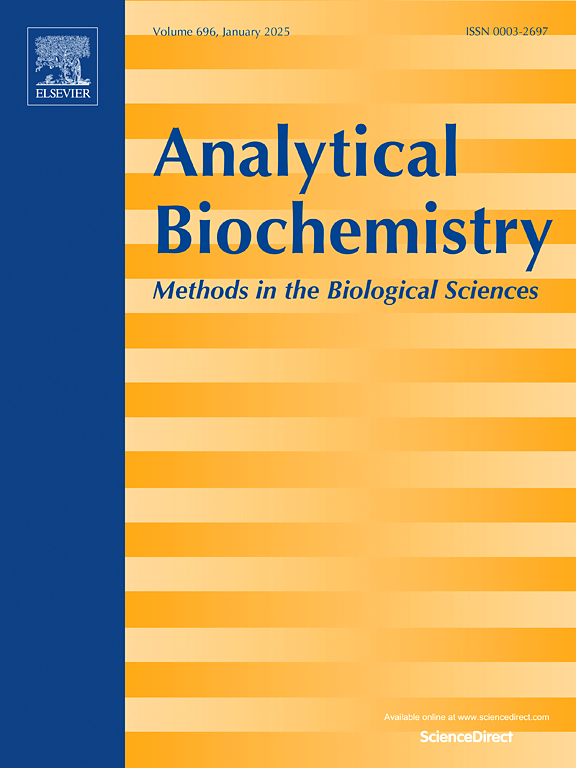TMB底物组成对ELISA信号增强作用的系统研究
IF 2.5
4区 生物学
Q2 BIOCHEMICAL RESEARCH METHODS
引用次数: 0
摘要
3,3 ',5,5 ' -四甲基联苯胺(TMB)仍然是比色免疫测定(包括酶联免疫吸附测定(ELISA))中最广泛使用的辣根过氧化物酶(HRP)显色底物之一。尽管早在40多年前就将TMB引入了ELISA工作流程,但系统优化TMB底物配方的研究仍然有限。该领域的最新进展提出了加强HRP催化的创新方法,例如使用深共晶溶剂和离子液体,以及研究TMB及其类似物的化学性质以确定更有效的替代品。然而,为临床诊断开发稳定和高性能的TMB解决方案需要全面了解配方参数如何影响信号强度和稳定性。在这项研究中,我们通过对影响TMB底物性能的关键因素进行系统评估来解决这些空白,包括缓冲液的pH、组成和摩尔浓度、特定离子效应、有机溶剂的掺入以及聚合物稳定剂的使用。此外,通过广泛的文献和专利审查确定了新的信号放大策略,并进行了实验测试。在此基础上,我们优化了TMB的配方,最终浓度为0.2 mol/L柠檬酸钠缓冲液(pH 4.5)、5% DMSO、0.37 mmol/L CaCl2、0.4 mmol/L 2-羟基-β-环糊精、0.8 mmol/L TMB和1.3 mmol/L H2O2。该优化配方的性能进行了评估,比较以前报道的配方从文献。本文章由计算机程序翻译,如有差异,请以英文原文为准。

A systematic investigation of TMB substrate composition for signal enhancement in ELISA
3,3′,5,5′-Tetramethylbenzidine (TMB) remains one of the most widely utilized chromogenic substrates for horseradish peroxidase (HRP) in colorimetric immunoassays, including enzyme-linked immunosorbent assays (ELISA). Despite its introduction into ELISA workflows over four decades ago, limited research has been conducted to systematically optimize TMB substrate formulations. Recent advancements in the field have proposed innovative approaches to enhance HRP catalysis, such as the use of deep eutectic solvents and ionic liquids, alongside investigations into the chemical properties of TMB and its analogs to identify more efficient alternatives. However, the development of stable and high-performance TMB solutions for clinical diagnostics requires a comprehensive understanding of how formulation parameters influence signal intensity and stability. In this study, we address these gaps by conducting a systematic evaluation of key factors affecting TMB substrate performance, including buffer pH, composition and molarity, specific ion effects, incorporation of organic solvents, and the use of polymer stabilizers. Additionally, novel strategies for signal amplification, identified through an extensive review of literature and patents, were experimentally tested. Based on these findings, we developed an optimized TMB formulation comprising 0.2 mol/L sodium citrate buffer (pH 4.5), 5 % DMSO, 0.37 mmol/L CaCl2, 0.4 mmol/L 2-hydroxy-β-cyclodextrin, 0.8 mmol/L TMB, and 1.3 mmol/L H2O2 as final concentrations. The performance of this optimized formulation was evaluated in comparison to previously reported formulations from the literature.
求助全文
通过发布文献求助,成功后即可免费获取论文全文。
去求助
来源期刊

Analytical biochemistry
生物-分析化学
CiteScore
5.70
自引率
0.00%
发文量
283
审稿时长
44 days
期刊介绍:
The journal''s title Analytical Biochemistry: Methods in the Biological Sciences declares its broad scope: methods for the basic biological sciences that include biochemistry, molecular genetics, cell biology, proteomics, immunology, bioinformatics and wherever the frontiers of research take the field.
The emphasis is on methods from the strictly analytical to the more preparative that would include novel approaches to protein purification as well as improvements in cell and organ culture. The actual techniques are equally inclusive ranging from aptamers to zymology.
The journal has been particularly active in:
-Analytical techniques for biological molecules-
Aptamer selection and utilization-
Biosensors-
Chromatography-
Cloning, sequencing and mutagenesis-
Electrochemical methods-
Electrophoresis-
Enzyme characterization methods-
Immunological approaches-
Mass spectrometry of proteins and nucleic acids-
Metabolomics-
Nano level techniques-
Optical spectroscopy in all its forms.
The journal is reluctant to include most drug and strictly clinical studies as there are more suitable publication platforms for these types of papers.
 求助内容:
求助内容: 应助结果提醒方式:
应助结果提醒方式:


